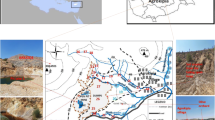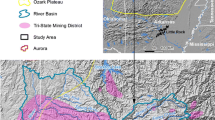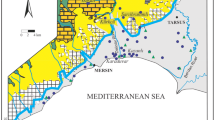Abstract
The Hasangazi chromite pit is an abandoned mine located to the east of the town of Pülümür (Tunceli, Turkey). The surface water that circulates in the pit flows into the Pülümür stream via the Turnadere creek. The quality of the surface water and soil from the region is important regarding the ecosystem in the Tunceli area. The open pit operations in the chromite deposits may be the cause of toxic element enrichments. To understand the effects of such pits, samples from the sediments, soil, waste material, and surface water were collected from the Hasangazi pit and its surrounding area. Samples were mineralogically and geochemically analyzed by XRD, ICP-OES, and ICP-MS methods. Mineralogical analyses showed the presence of chrysotile and plagioclase in the sediment and soil samples. These samples are also enriched in toxic elements, e.g., Cr, Ni, and Co. In particular, the Cr and Ni concentrations exceed the limits of soil pollution regulation of Turkey and the US Environmental Protection Agency. Overall the Cr, Ni, and chrysotile contents demonstrate the impact of the abandoned pit and the ultramafic rocks. Moreover, the surface water samples in the dry season have Zn concentrations above the toxic levels that may have been derived from the volcanic rocks. Environmental remediation precautions should immediately be taken around this inactive pit.








Similar content being viewed by others
References
Andreani M, Mevel C, Boullier AM, Escartin J (2007) Dynamic control on serpentine crystallization in veins: constraints on hydration processes in oceanic peridotites. Geochem Geophys Geosyst 8:1–24
Baba A, Güngör T (2002) Influence of gold mine on groundwater quality (Efemçukuru, Izmir, Turkey). Environ Geol 41:621–627
Birkle P, Torres-Alvarado IS (2010) Water-Rock interaction XIII. Taylor and Francis, London
Candeias C, Ferreira Da Silva E, Salguerio AR, Pereira HG, Reis AP, Patinha C, Matos JX, Avila PH (2011) Assessment of soil contamination by potentially toxic elements in the Aljustrel Mining Area in order to implement soil reclamation strategies. Lan Degrad Dev 22:565–585
Carrillo-Chavez A, Morton-Bermea O, Gonzalez-Partida E, Rivas- Solorzano H, Oesler G, Garcia-Meza V, Hernandez E, Morales P, Cienfuegos E (2003) Environmental geochemistry of the Guanajuato Mining District, Mexico. Ore Geol Rev 23:277–297
Çimen O, Toksoy-Köksal F, Öztüfekçi-Önal A, Örgün-Tutay Y (2015) Environmental contamination of heavy metals and chrysotile asbestos in the Munzur and Pülümür streams (Tunceli/Turkey). Ofioliti 40:27–36
Çimen O, Toksoy-Köksal F, Öztüfekçi-Önal A, Aktağ A (2016) Depleted to refertilized mantle peridotites hosting chromitites within the Tunceli Ophiolite, Eastern Anatolia (Turkey): insights on the back arc origin. Ofioliti 41:1–20
Dayan AD, Paine AJ (2001) Mechanism of chromium toxicity, carcinogenicity and allergenicity: review of the literature from 1985 to 2000. Hum Exp Toxicol 20:439–451
Doran JW, Parkin TB (1994) Defining and assessing soil quality. In: Doran JW, Coleman DC, Bezdicek DF, Stewart BA (eds) Defining soil quality for a sustainable environment. Soil Science Society of America, Madison, pp 3–21
Erarslan C, Örgün Y, Bozkurtoğlu E (2014) Geochemistry of trace elements in the Keşan coal and its effect on the physicochemical features of ground- and surface waters in the coal fields, Edirne, Thrace Region, Turkey. Int J Coal Geol 133:1–12
Fijalkowski K, Kacprzak M, Grobelak A, Placek A (2012) The influence of selected soil parameters on the mobility of heavy metals in soils. Inżynieria i Ochrona Środowiska 15:81–92
Fu X, Wang J, Zeng Y, Tan F, He J (2010) Geochemistry and origin of rare earth elements (REEs) in the Shengli River oil shale, northern Tibet, China. Chem Erde-Geochem 71:21–30
Gadd GM, White C (1993) Microbial treatment of metal pollution—a working biotechnology. Trends Biotechnol 11:353–359
Güleç N, Çancı-Günal B, Erler A (2011) Assessment of soil and water contamination around an ash-disposal site: a case study from the Seyitömer coal-fired power plant in western Turkey. Environ Geol 40:331–344
Han FX (2007) Biogeochemistry of trace elements in arid environments. Springer, Berlin
Hill MK (1997) Understanding environmental pollution. Cambridge University Press, Cambridge
Jaishankar M, Tseten T, Anbalagan N, Mathew BB, Beeregowda KN (2014) Toxicity, mechanism and health effects of some heavy metals. Interdiscip Toxicol 7:60–72
James CN, Copeland RC, Lytle DA (2004) Relationships between oxidation-reduction potential, oxidant, and pH in drinking water. In: American Water Works Association, WQTC Conference, pp 1–13
Kabata-Pendias A (2004) Soil-plant transfer of trace elements—an environmental issue. Geoderma 122:143–149
Kabata-Pendias A, Pendias H (1992) Trace elements in soils and plants, 2nd edn. CRC Press, Boca Raton
Karlen DL, Diztler CA, Andrews SS (2003) Soil quality: why and how? Geoderma 114:145–156
Kasper-Zubillaga JJ, Acevedo-Vargas B, Bermea OM, Zamora GO (2008) Rare earth elements of the Altar Desert dune and coastal sands, Northwestern Mexico. Chem Erde-Geochem 68:45–59
Lafay R, Montes-Hernandez G, Janots E, Chiriac R, Fingling N, Toche F (2012) Mineral replacement rate of olivine by chrysotile and brucite under high alkaline conditions. J Cryst Growth 347:62–72
Langård S, Vigander T (1983) Occurrence of lung cancer in workers producing chromium pigments. Br J Ind Med 40:71–74
Leivouri M (1998) Heavy metal contamination in surface sediments in the Gulf of Finland and comparison with the Gulf of Bothnia. Chemosphere 36:43–59
MacFarlane GR, Burchett MD (2000) Cellular distribution of Cu, Pb and Zn in the Grey Mangrove Avicennia marina (Forsk.) Vierh. Aquat Bot 68:45–59
Maher WA, Aislabie J (1992) Polycyclic aromatic hydrocarbons in nearshore marine sediments of Australia. Sci Total Environ 112:143–164
Martin R, Dowling K (2013) Trace metal contamination of mineral spring water in an historical mining area in regional Victoria, Australia. J Asian Earth Sci 77:262–267
McBride MB (1994) Environmental chemistry of soils. Oxford University Press, New York
Monjezi M, Shahriar K, Dehghani H, Samimi Namin F (2009) Environmental impact assessment of open pit mining in Iran. Environ Geol 58:205–216
MTA (2008) Geology Report of J42-J43. Mineral Research & Exploration General Directorate, Ankara
Müller G (1969) Index of geoaccumulation in sediments of the Rhine River. GeoJournal 2:108–118
Nolan RP, Langer AM, Ross M, Wicks FJ, Martin RF (2001) The health effects of chrysotile asbestos. Mineralogical Association of Canada Special Publications, Ottawa
Nriagu JO (1990) Global metal pollution: poisoning the biosphere? Environment 32:7–33
Olias M, Cerón J, Fernández I, De la Rosa I (2005) Distribution of rare earth elements in an alluvial aquifer affected by acid mine drainage: the Guadiamar aquifer (SW Spain). Environ Pollut 135:53–64
Öztüfekçi Önal A, Çimen O, Toksoy-Köksal F, Aktağ A, Önal A (2015) Petrogenetic characteristics of the chromite deposits in Tunceli Province (Turkey). In: Symposium on eastern anatolian geology, Van, Turkey, pp 152–153
Pattnaik BK, Equeenuddin SM (2016) Potentially toxic metal contamination and enzyme activities in soil around chromite mines at Sukinda Ultramafic Complex, India. J Geochem Explor 168:127–136
Plant J, Smith D, Smith B, Williams L (2001) Environmental geochemistry at the global scale. Appl Geochem 16:1291–1308
Prasad MNV, Freitas HMO (2003) Metal hyperaccumulation in plants—biodiversity prospecting for phytoremediation technology. Electron J Biotechnol 6:275–321
Rantitsch G, Melcher F, Meisel T, Rainer T (2003) Rare earth, major and trace elements in Jurassic manganese shales of the Northern Calcareous Alps: hydrothermal versus hydrogenous origin of stratiform manganese deposits. Miner Petrol 77:109–127
Rudnick RL, Gao S (2004) Composition of the continental crust. In: Holland HD, Turekian KK (eds) Treatise on geochemistry. Elsevier, Amsterdam, pp 1–64
Schatzel SJ, Stewart BW (2003) Rare earth element sources and modification in the Lower Kittanning coal bed, Pennsylvania: implications for the origin of coal mineral matter and rare earth element exposure in underground mines. Int J Coal Geol 54:223–251
Schuurmann G, Market B (1998) Ecotoxicology, ecological fundamentals, chemical exposure, and biological effects. Wiley, New York
Smith AH, Wright CC (1996) Chrysotile asbestos is the main cause of pleural mesothelioma. Am J Ind Med 30:252–266
Solgi E, Parmah J (2015) Analysis and assessment of nickel and chromium pollution in soils around Baghejar Chromite Mine of Sabzevar Ophiolite Belt, Northeastern Iran. Trans Nonferr Met Soc 25:2380–2387
Springer RK, Craig JR (1975) Sulfide mineralogy of metamorphosed ultramafic rocks, western Sierra Nevada foothills, California. Econ Geol 70:1478–1483
Stanin FT, Pirnie P (2004) The transport and fate of Cr(VI) in the environment. In: Guertin J, Jacobs JA, Avakian CP (eds) Chromium (IV) handbook. CRC Press, Florida, pp 165–214
Taylor SR, McLennan SM (1985) The continental crust: its composition and evolution. Blackwell, Oxford
Thomas JB, Bodnar RJ, Shimizu N, Chesner CA (2003) Melt inclusions in zircon. Rev Miner Geochem 53:63–87
Turekian KK, Wedepohl KH (1961) Distribution of the elements in some major units of the earth’s crust. Geol Soc Am Bull 72:175–192
Wang J, Fu XG, Li ZX, Wu T, He JL (2008) Discovery of the Shenglihe-Changsheshan oil shale belt in the Qiangtang basin, northern Tibet, China and its significance. Bull Geol Soc China 28:691–695
Weill DF, Drake MJ (1973) Europium anomaly in plagioclase feldspar: experimental results and semiquantitative model. Science 180:1059–1060
Wilson BM (1989) Igneous petrogenesis: a global tectonic approach. Unwin Hyman, London
Wu Y, Zhou X, Lei M, Yang J, Ma J, Qiao P, Chen T (2017) Migration and transformation of arsenic: contamination control and remediation in realgar mining areas. Appl Geochem 77:44–51
Turkey Soil Pollution Control Regulation (SPCR). http://www.csb.gov.tr/gm/cygm/
Turkey Water Pollution Control Regulation (WPCR). http://www.csb.gov.tr/gm/cygm/
US Environmental Protection Agency (EPA). https://www.epa.gov/
Yuce G, Pinarbasi A, Ozcelik S, Ugurluoglu D (2005) Soil and water pollution derived from anthropogenic activities in the Porsuk River Basin, Turkey. Environ Geol 49:359–375
Zanin YN, Eder VG, Zamirailova AG, Krasavchikov VO (2010) Models of the REE distribution in the black shale Bazhenov Formation of the West Siberian marine basin, Russia. Chem Erde-Geochem 70:363–376
Acknowledgements
This research was supported by Munzur University (Project Number: YLTUB011-13). Thanks to this relevant institution for its contributions. The authors also gratefully acknowledge Dr. Halim Mutlu for earlier revisions of the manuscript. Also, Dr. James W. LaMoreaux and three anonymous reviewers are sincerely thanked for their thoughtful comments and suggestions which scientifically improved the manuscript.
Author information
Authors and Affiliations
Corresponding author
Rights and permissions
About this article
Cite this article
Çimen, O., Öztüfekçi Önal, A. & Akyol, E.A. Assessment of pollution potential of the Hasangazi chromite pit (Tunceli, Turkey): implications for the natural environment. Environ Earth Sci 77, 199 (2018). https://doi.org/10.1007/s12665-018-7391-9
Received:
Accepted:
Published:
DOI: https://doi.org/10.1007/s12665-018-7391-9




